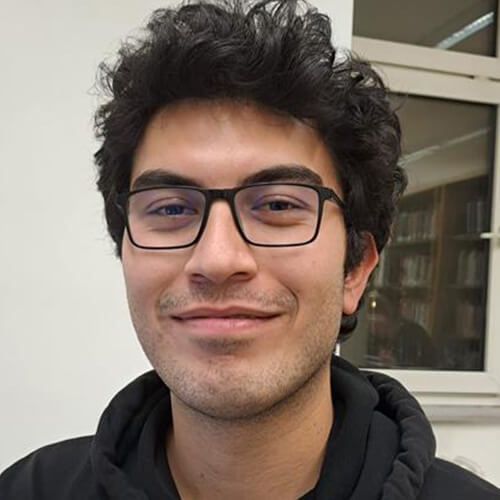EVENT
Friday, April 25, 2025
2025 NanoSI Industry Engagement Board (IEB) Meeting
ABOUT THE EVENT
We are thrilled to extend a warm welcome to you for the second Industrial Engagement Board (IEB) Meeting of NanoSI on Friday, April 25th. This event promises to be an engaging platform where we will showcase the latest in groundbreaking research and developments. Moreover, it provides an ideal setting to explore collaboration opportunities aimed at reshaping the landscape of chip-level technology advancements and applications.
ABOUT NANOSI
Northeastern University’s Institute for NanoSystems Innovation (NanoSI) is a global hub focused on pioneering semiconductor exploration, learning, and innovation. We’re also an open center for industry-university collaborative research. Our industry-driven research spans a broad range of MEMS, semiconductor devices, circuits, and systems, enabling innovations in many areas including sensors, wearable and implantable electronics, 5G/6G communications, and wireless IoT devices.
DATE
Friday, April 25, 2025
TIME
8:30AM ET—7:30PM ET
LOCATION
8th Floor EXP Building,
815 Columbus Avenue,
Boston, MA 02120
CONTACT
w.zhang@northeastern.edu
AGENDA
08:30 – 09:00
Registration and Continental Breakfast
09:00-09:30
Welcome and Opening Remarks
Overview and Status Report of the Institute

Matteo Rinaldi
Speaker
Co-Director of the Institute for NanoSystems Innovation; Professor, Northeastern University

David Horsley
Speaker
Co-Director of the Institute for NanoSystems Innovation; Professor, Northeastern University
09:30-10:00
Keynote Speech
The Florida Semiconductor Institute: R&D, Workforce, and Ecosystem Building

David P. Arnold
Keynote Speaker
Director, Florida Semiconductor Institute
George Kirkland Engineering Leadership Professor
Department of Electrical and Computer Engineering
10:00-10:30
Faculty Spotlight
Digital Twin: Driving Innovation at the Nexus of Integrated Microsystems Development and Semiconductor Manufacturing

Ben Davaji
Faculty Spotlight
Assistant Professor, ECE
Autonomous Integrated Microsystems (AIMS) Laboratory
10:30-10:45
Coffee Break
10:00-10:30
Faculty Spotlight
Advancing Sensing Microtechnologies in the Era of Artificial Intelligence and the Ubiquitous Internet of Things
11:15-11:35
Oral Presentation
Protecting Sensor Hardware from Electromagnetic Side-channel Leakage and Data Injection
Yan Long (Postdoc)
PI: Prof. Kevin Fu
ABSTRACT:
Modern cyber-physical systems (CPS) depend on sensors to acquire physical information and make control decisions. For example, IoT devices and other embedded systems are increasingly equipped with camera sensors that can sense critical visual information in private spaces. While researchers have explored the data security of IoT cameras and the TEMPEST risks of computer monitors, a less explored problem is understanding how much camera data leaks through analog side channels of modern camera hardware interconnects such as MIPI CSI-2 cabling.
Our NDSS 2024 paper presents the first attempt to analyze the attack surface of physical- channel eavesdropping on embedded CMOS camera sensors. We characterize EM Eye—a vulnerability in the image data transmission interface that allows adversaries to reconstruct real-time image streams from the camera circuits’ unintentional electromagnetic emissions using software-defined radio (SDR), even from meters away and through walls. Our research shows EM Eye poses threats to a wide range of camera devices, from smartphones to dash cams and home security cameras.
This talk will demonstrate how standardized but unprotected data transmission interfaces allow for physical eavesdropping attacks and explain the underlying causality. I will discuss how this vulnerability connects to the long-standing problem of TEMPEST eavesdropping attacks against computer displays and how it could generalize over other types of sensing-based information systems, such as smart locks that employ fingerprint sensors. The talk aims to call attention to the fundamental problem of hardware and physical layer protections in sensor peripherals. I will further discuss how our ongoing work RF-Eye-D utilizes these side channels to physically inject watermarking information into CMOS camera images, enabling a range of applications such as geotagging and image source verification.

11:35-11:55
Oral Presentation
Ultra-Low Power Current Mode Distance Calculation Circuit for K-Means Clustering
Nishant Biyani
PI: Prof. Aatmesh Shrivastava
ABSTRACT:
K-means clustering algorithm partitions data into k unique and non-overlapping sets. Although the method primarily uses Euclidean distance, dissimilarity within datasets can be assessed using a variety of metrics. This work focuses on assessing the performance of the K-means clustering algorithm using three distinct distance metrics: (i) Euclidean distance (L22 norm), (ii) A proposed circuit design distance metric, and (iii) Manhattan distance (L2norm). However, integrating this type of functionality within a traditional CMOS design demands expensive hardware and results in considerable power consumption. The design’s performance was assessed using a standard K-means clustering algorithm with K=4 on the “Iris flower dataset”.
Findings indicate a classification throughput of 500 ns and a power consumption below 1 μW, achieving significantly lower energy consumption compared to a conventional digital CMOS design in 65 nm commercial CMOS technology.

11:55-12:15
Oral Presentation
Magnetic Field Sensing with an Enhanced Sub-mm Electro-Optic Sensor for Interventional Magnetic Resonance Imaging
Alp Derin
PI: Prof. Soner Sonmezoglu
ABSTRACT:
Technologies that enable precise localization and real-time tracking of interventional devices, such as catheters, under magnetic resonance imaging (MRI) are necessary to guide minimally invasive interventions for high-risk patients. Most research has focused on passive and active devices to enable MRI-based catheter tracking. Passive devices often formed by magnetic materials suffer from poor contrast and orientation-dependent artifacts [1].
On the other hand, most active devices have an inherent limitation of radiofrequency (RF)-induced heating inside the body because these devices convey the detected RF magnetic field signal on a long electrical cable to an MRI system outside the body [2]. Active devices based on the transduction of the RF signal in the optical domain have recently been proposed to enable signal routing on an optical fiber without any cables [3,4], eliminating the RF heating safety risk. However, deployment of these devices is currently limited by localized tissue heating due to IC power dissipation [3] or large size [4], frequently causing post-operative complications. To overcome these limitations, a proof-of-concept magnetic field sensing probe for 1.5T MRIs was demonstrated in our previous work.
The probe was constructed using our first generation optical microresonator (OMR) coupled to an optical fiber and electrically connected to a loop antenna. Unlike [2,3], the sensor is designed to operate safely with virtually zero probe power/heat-up. Compared to [4], our unique approach enabled mm-scale probe size while achieving a competitive resolution of 20pT/ÖHz. Here, we propose an enhanced ultra-miniature magnetic field sensor constructed using our next generation sub-mm OMRs with high optical modulation gain, which is optically coupled to a 45º polished V-groove fiber and electrically connected to a miniature loop antenna.
The enhanced magnetic field probe achieves ~10x size reduction compared to [4] while achieving an ~184-fold improvement in magnetic field resolution compared to our proof-of-concept magnetic field sensing probes.

12:15-13:15
Lunch
13:15-13:35
Oral Presentation
Generative AI for Targeted Discovery of Analog Circuit Topologies
Jian Gao
PI: Prof. Xuan (Silvia) Zhang
ABSTRACT:
Analog circuit design has traditionally depended on manual expertise, slowing the discovery of novel topologies essential for advanced technologies like AI, 5G/6G, and quantum computing. While AI-driven methods have accelerated hardware design workflows, most of them focus on topology synthesis, often reusing known structures to achieve specific goals. The challenge of discovering entirely new, high-performance topologies remains largely underexplored due to its abstract nature.
In this work, we introduce EVA, an efficient and versatile generative engine for discovering novel analog circuit topologies. EVA employs a bottom-up generation framework, using a decoder-only transformer to sequentially predict device pin connections and create diverse circuits from scratch. Pretraining on unlabeled circuit topologies builds foundational knowledge about circuit connectivity, achieving baseline discovery efficiency by generating valid circuits and reducing performance-labeled samples needed in fine-tuning.
For targeted discovery of high-performance designs, EVA leverages two fine-tuning strategies—proximal policy optimization (PPO) and direct preference optimization (DPO)—to further enhance discovery efficiency for relevant, high-performing topologies. Experimental results across various circuit types highlight EVA’s strengths in validity, novelty, versatility, and both training sample and discovery efficiency.

13:35-13:55
Oral Presentation
GHz Ultrasound for Cell and Soft Tissue Mechanobiology
Yilmaz Arin Manav
PI: Prof. Benyamin Davaji
ABSTRACT:
Quantitative characterization of mechanical properties at cell and tissue level requires mechanical probing schemes that are usually invasive and limited to a single point measurement such as atomic force microscopy (AFM), micro indentation, and pipette aspiration. State-of-the-art methods such as traction force microscopy (TFM) use fiducial markers, which is undesirable when label-free measurement is needed. This paper presents a quantitative characterization method for cell and soft tissue mechanobiology that is performed using an AlN piezoMEMS GHz ultrasound transducer array. The GHz frequency of operation provides a submicron axial resolution in liquid samples (λ = 0.832µm at fo = 1.8GHz in water). The high axial resolution of GHz ultrasound overcomes the resolution limit of traditional chip-scale ultrasound arrays that commonly operate at MHz frequencies, which range from millimeters to hundreds of microns even when using techniques like harmonic imaging. Achieving this resolution makes GHz ultrasound a promising tool for the quantitative measurement of cell and tissue scale samples for mechanobiology.
Using our GHz ultrasound array (128×128 elements, 50×50 µm/pixel) with pulse-echo reflectometry method at GHz frequencies we have displayed several mechanical probing applications such as measuring the real-time spatial distribution of hydrogel stiffness for stiffness-tuning, acoustic impedance of oocyte cells for improving the oocyte selection process in assistive reproductive technologies (ART) and detection of in-plane acoustic impedance heterogeneity in tissue samples. The results from these studies have shown that GHz ultrasound will enable quantitative direct mechanobiology probing and microscale elastography with the capability to map spatial distribution of mechanical properties in real time for a wide range of sample sizes (µm to mm) and sample types such as biological tissues, cells, biomimetic materials, buffer solutions, and aggregation of biomaterials.

13:55-14:15
Oral Presentation
High-Performance 18 GHz Filters Based on Cross-Sectional Lamé Mode Resonators Using 30% Scandium-Doped AlN for Ku-Band and mmWave Applications
Luca Spagnuolo
PI: Prof. Matteo Rinaldi
ABSTRACT:
Emerging communication paradigms, such as 5G and 6G, are creating demand for compact, efficient, and scalable RF components capable of operating in the Ku band and mmWave frequencies. The development of advanced piezoelectric materials such as Scandium-doped Aluminum Nitride (ScAlN), has played a pivotal role in addressing these challenges, enabling high-quality factors (Q) and electromechanical coupling (kt2). Cross-Sectional Lamé Mode Resonators (CLRMs) have further enhanced device performance by enabling efficient energy confinement and reducing power dissipation.
This work presents the design, fabrication, and characterization of first-order filters operating at 18 GHz, based on cross-sectional Lamé mode resonators using 30% Scandium-doped Aluminum Nitride (ScAlN). The best first order filter shows an Insertion Loss (IL) of -1.74 dB, a Fractional Bandwidth (FBW) of 2.62%, and a center frequency (fc) of 17.48 GHz .Overall, these results are highly promising and highlight the potential of the fabricated devices for advanced high-frequency and wideband filter applications.

14:15-15:15
Poster Presentation
15:15-15:45
Member/Researcher Mixer
15:45-16:30
Lab Tour (ISEC, EXP, and Cleanroom)
16:30-17:30
Industrial Engagement Board Meeting
Open to Members and Prospective Members
17:30-19:30
Dinner (Core Faculty and Industry Participants)
19:30
Adjourn

